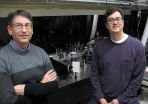(Press-News.org) PROVIDENCE, R.I. - Where you live affects the type of bacteria that cause bloodstream infections, according to researchers at Rhode Island Hospital and an international team of investigators. The closer you live to the equator, the greater the likelihood of a bloodstream infection caused by a group of bacteria called Gram-negative bacteria, which thrive in warm and moist environments, compared to another group of bacteria referred to as Gram-positive bacteria. The study also found that the proportion of a country's GDP spent on health care impacted the type of bacteria causing such infections. The study was published in the scientific journal PLOS ONE.
"This study reflects the fascinating interaction of the environment, human health, and economic factors that together help shape the sorts of diseases that become manifest in different parts of the world," said Leonard Mermel, D.O., medical director of the department of epidemiology and infection control at Rhode Island Hospital. "A better understanding of this phenomenon may help us prepare for the effects they have on future human generations around the globe. In addition, such information may assist physicians who need to empirically administer antibiotics to patients with possible bloodstream infections in different areas of the world."
Mermel, corresponding author, was part of a five-member international steering committee that collected and studied data from 2007-2011 from 23 medical centers (with two hospitals participating from Sao Paolo, Brazil) including in the U.S., Greece, Egypt, Israel, Australia, Canada, Japan, Italy, Netherlands, Thailand, Switzerland and Argentina. For each site, data was obtained regarding latitude, longitude, mean annual precipitation, mean daily temperature, population density, per-capita gross domestic product and the percentage of GDP in that country allocated for health care.
"It's fascinating to discover how geography and socioeconomic determinants factor into disease management," said Mermel. "This five-year study indicates that the likelihood that bloodstream infections by Gram-negative bacteria correlates with distance from the equator and health care spending."
INFORMATION:
There was no funding for this study. Leonard Mermel's principal affiliation is Rhode Island Hospital, a member hospital of the Lifespan health system in Rhode Island. He also has an academic appointment at The Warren Alpert Medical School of Brown University, department of epidemiology and infection control. Others contributing to the study include D. Fisman, E. Patrozou, Y. Carmelli, E. Perencevich, AR Tuite, Rodolfo Quiros, Viviana Vilches, Tony Korman, Spyros Miyakis, Craig Boutlis, Alistair Reid, Ana Gales, Lygia Schandert, Rafael Affini, Antonia Machado, Alexandre Marra, Luis Camargo, Michael Edmond, Luci Correa, Teresa Sukiennik, Paulo Behar, Evelyne Girão, Carla Guerra, Carlos Brites, Allison McGeer, Stephanie Smith, Amani El Kholy, George Plakias, Evelina Tacconelli, Hitoshi Honda, Jan Kluytmans, Anucha Apisarnthanarak, Mohamad Fakih, Jonas Marschall, Anthony Russo, Marta Antunes de Souza
About Rhode Island Hospital
Founded in 1863, Rhode Island Hospital in Providence, R.I., is a private, not-for-profit hospital and is the principal teaching hospital of The Warren Alpert Medical School of Brown University. A major trauma center for southeastern New England, the hospital is dedicated to being on the cutting edge of medicine and research. Last year, Rhode Island Hospital received more than $50 million in external research funding. It is also home to Hasbro Children's Hospital, the state's only facility dedicated to pediatric care. For more information on Rhode Island Hospital, visit http://www.rhodeislandhospital.org, follow us on Twitter @RIHospital or like us on Facebook http://www.facebook.com/rhodeislandhospitalpage.
DALLAS - Dec. 18, 2014 - Retroviruses are best known for causing contagious scourges such as AIDS, or more sporadically, cancer.
But researchers at UT Southwestern Medical Center and Karolinska Institutet in Stockholm, Sweden, found that endogenous retroviruses (ERV) also play a critical role in the body's immune defense against common bacterial and viral pathogens.
"Most scientists have become used to the view that retroviruses are generally harmful," said Nobel Laureate Dr. Bruce Beutler, Professor and Director of UT Southwestern's Center for the Genetics of Host ...
Primates visually recognise and determine the category of an object even at a brief glance, and to date, this behaviour has been unmatched by artificial systems. A study publishing this week in PLOS Computational Biology has found that the latest artificial "deep neural network" performs as well as the primate brain at object recognition.
Charles Cadieu and colleagues from MIT measured the brain's object recognition ability by implanting arrays of electrodes in the inferior temporal cortex of macaques. This allowed the researchers to see the neural representation -- the ...
A definitive geological timeline shows that a series of massive volcanic explosions 66 million years ago spewed enormous amounts of climate-altering gases into the atmosphere immediately before and during the extinction event that claimed Earth's non-avian dinosaurs, according to new research from Princeton University.
A primeval volcanic range in western India known as the Deccan Traps, which were once three times larger than France, began its main phase of eruptions roughly 250,000 years before the Cretaceous-Paleogene, or K-Pg, extinction event, the researchers report ...
(Boston)--Dr. Deborah Anderson from Boston University School of Medicine (BUSM) and her colleagues are challenging dogma about the transmission of the human immunodeficiency virus type 1 (HIV-1). Most research has focused on infection by free viral particles, while this group proposes that HIV is also transmitted by infected cells. While inside cells, HIV is protected from antibodies and other antiviral factors, and cell-to-cell virus transmission occurs very efficiently through intercellular synapses. The Journal of Infectious Diseases (JID) has devoted their December ...
EUGENE, Ore. -- Dec. 18, 2014 -- Four pulses of laser light on nanoparticle photocells in a University of Oregon spectroscopy experiment has opened a window on how captured sunlight can be converted into electricity.
The work, which potentially could inspire devices with improved efficiency in solar energy conversion, was performed on photocells that used lead-sulfide quantum dots as photoactive semiconductor material. The research is detailed in a paper placed online by the journal Nature Communications.
In the process studied, each single photon, or particle of ...
Washington, DC--As people in developing nations relocate from rural areas to cities, the increased stress is affecting their hormone levels and making them more susceptible to diabetes and other metabolic disorders, according to a new study published in the Endocrine Society's Journal of Clinical Endocrinology & Metabolism (JCEM).
About 387 million people worldwide have diabetes, and 77 percent of them live in low- and middle-income countries, according to the International Diabetes Federation. In the Middle East and north Africa, one in 10 adults has diabetes.
One ...
Washington, DC--Women who experience moderate to severe hot flashes and night sweats during menopause tend to have lower bone mineral density and higher rates of hip fracture than peers who do not have menopausal symptoms, according to a new study published in the Endocrine Society's Journal of Clinical Endocrinology & Metabolism.
Menopause is the life stage when a woman's ovaries stop producing hormones and her menstrual periods stop. About 60 percent of women experience hot flashes, which can last for several years.
Postmenopausal women face a greater risk of developing ...
MAYWOOD, Ill. - A drug called ganciclovir is given to lung transplant patients to protect against a life-threatening virus that is common after transplantation.
Ganciclovir reduces mortality due to the virus from 34 percent to between 3 and 6 percent. But between 5 percent and 10 percent of patients infected with the virus have strains that are resistant to the drug.
A Loyola University Medical Center study found that such resistance may occur more frequently in cystic fibrosis patients. These patients were found to have insufficient levels of the drug in their bloodstream, ...
A group of researchers from the University of Barcelona (Spain), the CNRS in Montpellier (France) and Princeton University (USA) report in The American Naturalist that the vaccination of females of a long-lived seabird species, the Cory's shearwater, results in levels of antibodies that allow their transmission to their offspring for several years and could provide several weeks of protection after hatching to these offspring.
Over a period of 6 years, in the Canary Archipelago (Spain), the researchers tracked the immune status of a large number of adults and chicks, ...
VIDEO:
Using data from NASA/USGS satellite Landsat 8, scientists have measured how vegetation in the Colorado River Delta has responded to the pulse of water released in March 2014 as part...
Click here for more information.
A pulse of water released down the lower reaches of the Colorado River last spring resulted in more than a 40 percent increase in green vegetation where the water flowed, as seen by the Landsat 8 satellite. The March 2014 release of water - an experimental ...



